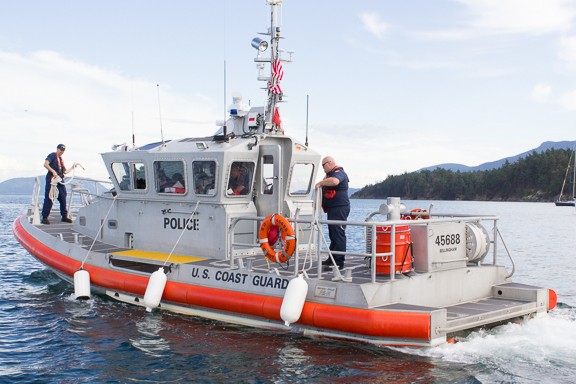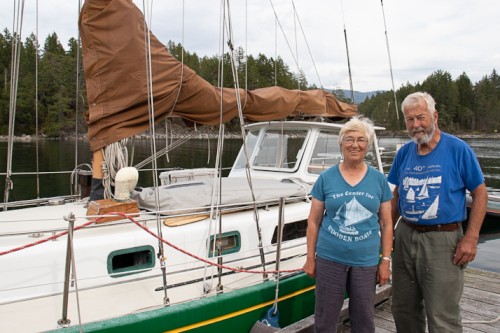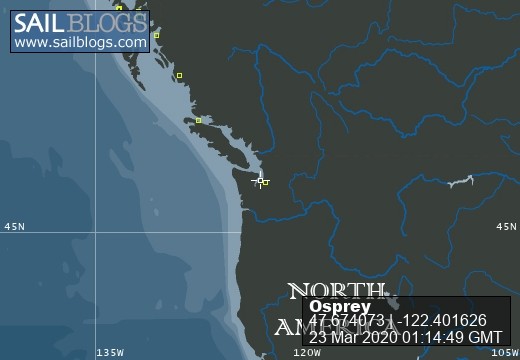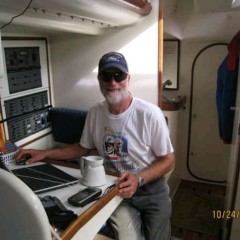Voyages North
23 July 2023
21 August 2021
11 July 2021 | Posted in Seattle
16 May 2021
07 January 2021
10 April 2020 | Posted in Seattle
31 August 2019 | Posted at Port McNeill
31 August 2019
30 August 2019
30 August 2019 | Posted at Port MCNeill
13 August 2019 | Posted at Prince Rupert
13 August 2019 | Posted at Prince Rupert
03 August 2019 | Posted at Ketchikan
02 August 2019 | Posted at Metlakatla
02 August 2019 | posted in Metlakatla AK
22 July 2019 | Posted at Klawock/Craig
22 July 2019 | Posted at Klawock/Craig
09 July 2019 | Posted at Juneau
09 July 2019 | Posted at Juneau
27 June 2019
Coast Guard Evacuation. Echo Bay, Sucia Island. September 5, 2015.
25 September 2015

Photo: A Coast Guard rescue boat leaving Echo Bay.
A scream erupted from Osprey's cockpit, "My back, my back, it hurts, it hurts." I dropped the jib sheet, which I was pulling to untangle the jib from the radar, and ran from the foredeck back to the cockpit. I saw a scene of confusion. Steve was ensnared in the mainsheet lines and struggling to untangle himself while his sister Morgan sat rigidly on the port cockpit seat, crying, "My back, my back. I can't move." Ann, another sister of Steve's, was trying to untangle the sheets.
"I've got to call the Coast Guard," shouted Steve. "Morgan's hurt. Help me get my foot out of the lines."
Ann scrambled to pull Steve's shoes off to so he could get his foot away from the lines. I straightened the sheets and got Osprey back on course. We had taken an accidental jibe.
In the past few weeks, as Steve and I had sailed south from Ketchikan, we overheard several dramatic rescues by the Canadian Coast Guard. We were impressed with their fast response and professional manner. Now we were going to get a chance to see how our own Coast Guard measured up.
Freed from the mainsheet lines, Steve picked up the radio microphone and spoke urgently, "U.S. Coast Guard, U.S. Coast Guard, this is Osprey, Osprey, over."
A Coast Guardsman answered and Steve said. "We had an accident; we need medical assistance."
The Coast Guardsman asked a few questions. "Where is she hurt? Can she move her fingers and toes?" (She could.) "How many people on board?" (4) "Are you all wearing lifejackets?" (We were.) and finally, "What are your GPS coordinates?" A few minutes later he told us a boat was on its way from Bellingham and its crew would be consulting with a flight surgeon when they arrived. They asked us to stay on Channel 22A in the meantime.
By then we had jibed back to our original course and rolled in the jib but were still sailing under the main. Steve had not wanted the noise of the engine while he was on the radio. Now Steve and I sailed the rest of the way into the bay, rounded up and dropped sail and anchor. Ann stayed with Morgan who was sitting in the same position, afraid to move, and saying over and over, "It hurts, it hurts."
After what seemed like an eternity, the Coast Guard called us and explained that their boat had stopped at Gooseberry Point to take on EMTs and would be at our position in 15 minutes.
In almost exactly 15 minutes, we saw a Coast Guard boat enter the bay. It tied up alongside Osprey and two men in Coast Guard uniforms and two in T-shirts with the words FIRE DEPARTMENT on their backs stepped onboard. They gathered around Morgan and started asking her questions and filling out a form.
"I need morphine," Morgan told them. As a nurse, Morgan knew exactly what she needed.
"We don't have any drugs on board, but we'll take you to an ambulance which will have painkillers. They will take you to the St. Joseph's hospital (actual name PeaceHealth St. Joseph's Medical Center) in Bellingham."
I was dismayed. It was a long trip back to Bellingham across Rosaio Strait and down Hale Passage. In a brisk afternoon wind, the ride could be bumpy.
The men placed Morgan on an inflatable splint, laid her on her back and moved her to a gurney on the CG boat. Ann asked to go with her and the CG agreed.

Photo: On the Coast Guard boat
Steve and I watched the CG boat leave the bay, then we hoisted anchor and followed, back to Bellingham where our trip had started that morning. We were both worried, imagining the worst: a broken bone or permanently damaged back.
Several hours later, Ann called to report that Morgan had no broken bones, only badly bruised ribs and an already bad shoulder made worse by the accident. The Coast Guard boat had taken them to Gooseberry Point in Hale Passage, rather than all the way to Bellingham. Once at Gooseberry Point, they had taken a short ambulance ride to another ambulance, where she was finally given painkillers. The trip had been rough and Ann had felt the Coast Guard drove the boat too fast.
The hospital released Morgan that night with prescriptions for painkillers and muscle relaxants. She and Ann found a nearby hotel for the night. A day and a half later, Morgan felt good enough to get underway again and we continued our (now shortened) trip south to Port Townsend.
Epilogue
The hospital had given Morgan only enough painkillers for two days and told her she would have to go to another doctor for more. We chose to do that at Friday Harbor at another PeaceHealth Clinic that could access her records.
"Oh you're the one, "the doctor said when Morgan told him the accident had happened at Sucia. He was the doctor in charge of emergency medicine for the San Juan Islands. According to him, the Coast Guard had made a mistake. Instead of taking Morgan all the way to Bellingham, they should have taken her to Brandt's Landing, a small harbor on the north side of Orcas Island less than five miles from Sucia. From there it would have been only a short ambulance ride to the Orcas Medical Clinic (see below for more on Brandt's Landing). The doctor told us he would be following up.
What happened and why.
At the time of the accident, we were sailing north of the Finger Islands in Echo Bay on Sucia Island with the wind behind us, heading towards an anchorage. To get a closer look at the chart plotter, which sits on the cabin top under the dodger, Steve had moved forward of the wheel and the traveler and was steering with the autopilot. (Osprey, an Annapolis 44, has a long cockpit with the boom sheeted to a traveler just forward of the wheel.) We had just jibed the jib to go wing-and-wing and I had gone forward to help the jib around the shrouds in the light air. The wind shifted suddenly, sending the boom rapidly across from starboard to port. The sheet caught Steve across his back, pushing him into Morgan and thrusting her against the fiberglass coaming. She couldn't remember for sure, but she thinks she put out her right arm, which already had a bad rotator cuff, to try to stop his fall.
Obviously, we should have had the preventer boomvang cleated down. We normally do when the wind's aft of the beam, but must have forgotten with the distraction of guests on board and navigating in close waters. We might also have avoided injuries by asking Morgan to sit farther forward, away from the sheet.
The experience was also a sobering reminder of the limitations of our first aid skills. Although both Steve and I have taken standard workplace first aid and First Aid at Sea, it wasn't enough. We were concerned that Morgan really had damaged her back, even after she told us she could move her fingers and toes. The Coast Guard had the ability - and the inflatable mattress splint - to move her.
Another surprise was the lack of painkillers on board the Coast Guard Boat. We do carry pain pills on Osprey (Percocet and Canadian over--counter ACC (Acetaminophen, Caffeine and Codeine) for situations where we are far from help. In retrospect we could have told the CG we had them and asked them to get a doctor's opinion on whether we should give them to Morgan.
The Coast Guard did respond quickly. But the experience made us realize that even in a populated area like the San Juan Islands, getting help is not as simple as calling 911 on land.
Brandt's Landing

Photo: Chart 18431 showing Sucia Island and the north shore of Orcas Island, including Brandt's landing.
We had never heard of Brandt's Landing. Had we known about it we might have been able to take Morgan there ourselves in Osprey in less than the time it took the Coast Guard to get to us. Not only is the marina close to the Orcas Medical Center, it's next door to an airfield for an air evacuation if necessary.
Brandt's Landing's isn't labeled on the chart and none of the guidebooks that we have for the San Juan Islands mentions it. Google Earth showed me a small inlet lined with docks. Curious, I googled it further and found a phone number. I called the number and talked to Eric Brandt, who told me the marina was started by his father 50 years ago. He confirmed that the marina has been used for medical emergencies. If someone is planning on coming in, they can call the marina's at 360-376-4477. "We try to help everybody we can," Mr. Brandt told me.
The marina is small with no transient moorage, but in an emergency, they can usually find short-term moorage for a boat. However, the marina has two serious limitations, especially for sailboats: the entrance is only 3ft deep at zero tide and is not well charted. At the time of the accident, we could have gone in but earlier in the day it would have been too shallow for our 6 ft draft.
Eric Brandt told me they are hoping to expand and dredge, to make the marina more useful for more boaters, with amenities such as fuel, a pumpout and sales of ice and other necessities. Look for a website, Brandtlanding.com, about the expansion in December, including interactive features to comment on the plan.
A scream erupted from Osprey's cockpit, "My back, my back, it hurts, it hurts." I dropped the jib sheet, which I was pulling to untangle the jib from the radar, and ran from the foredeck back to the cockpit. I saw a scene of confusion. Steve was ensnared in the mainsheet lines and struggling to untangle himself while his sister Morgan sat rigidly on the port cockpit seat, crying, "My back, my back. I can't move." Ann, another sister of Steve's, was trying to untangle the sheets.
"I've got to call the Coast Guard," shouted Steve. "Morgan's hurt. Help me get my foot out of the lines."
Ann scrambled to pull Steve's shoes off to so he could get his foot away from the lines. I straightened the sheets and got Osprey back on course. We had taken an accidental jibe.
In the past few weeks, as Steve and I had sailed south from Ketchikan, we overheard several dramatic rescues by the Canadian Coast Guard. We were impressed with their fast response and professional manner. Now we were going to get a chance to see how our own Coast Guard measured up.
Freed from the mainsheet lines, Steve picked up the radio microphone and spoke urgently, "U.S. Coast Guard, U.S. Coast Guard, this is Osprey, Osprey, over."
A Coast Guardsman answered and Steve said. "We had an accident; we need medical assistance."
The Coast Guardsman asked a few questions. "Where is she hurt? Can she move her fingers and toes?" (She could.) "How many people on board?" (4) "Are you all wearing lifejackets?" (We were.) and finally, "What are your GPS coordinates?" A few minutes later he told us a boat was on its way from Bellingham and its crew would be consulting with a flight surgeon when they arrived. They asked us to stay on Channel 22A in the meantime.
By then we had jibed back to our original course and rolled in the jib but were still sailing under the main. Steve had not wanted the noise of the engine while he was on the radio. Now Steve and I sailed the rest of the way into the bay, rounded up and dropped sail and anchor. Ann stayed with Morgan who was sitting in the same position, afraid to move, and saying over and over, "It hurts, it hurts."
After what seemed like an eternity, the Coast Guard called us and explained that their boat had stopped at Gooseberry Point to take on EMTs and would be at our position in 15 minutes.
In almost exactly 15 minutes, we saw a Coast Guard boat enter the bay. It tied up alongside Osprey and two men in Coast Guard uniforms and two in T-shirts with the words FIRE DEPARTMENT on their backs stepped onboard. They gathered around Morgan and started asking her questions and filling out a form.
"I need morphine," Morgan told them. As a nurse, Morgan knew exactly what she needed.
"We don't have any drugs on board, but we'll take you to an ambulance which will have painkillers. They will take you to the St. Joseph's hospital (actual name PeaceHealth St. Joseph's Medical Center) in Bellingham."
I was dismayed. It was a long trip back to Bellingham across Rosaio Strait and down Hale Passage. In a brisk afternoon wind, the ride could be bumpy.
The men placed Morgan on an inflatable splint, laid her on her back and moved her to a gurney on the CG boat. Ann asked to go with her and the CG agreed.

Photo: On the Coast Guard boat
Steve and I watched the CG boat leave the bay, then we hoisted anchor and followed, back to Bellingham where our trip had started that morning. We were both worried, imagining the worst: a broken bone or permanently damaged back.
Several hours later, Ann called to report that Morgan had no broken bones, only badly bruised ribs and an already bad shoulder made worse by the accident. The Coast Guard boat had taken them to Gooseberry Point in Hale Passage, rather than all the way to Bellingham. Once at Gooseberry Point, they had taken a short ambulance ride to another ambulance, where she was finally given painkillers. The trip had been rough and Ann had felt the Coast Guard drove the boat too fast.
The hospital released Morgan that night with prescriptions for painkillers and muscle relaxants. She and Ann found a nearby hotel for the night. A day and a half later, Morgan felt good enough to get underway again and we continued our (now shortened) trip south to Port Townsend.
Epilogue
The hospital had given Morgan only enough painkillers for two days and told her she would have to go to another doctor for more. We chose to do that at Friday Harbor at another PeaceHealth Clinic that could access her records.
"Oh you're the one, "the doctor said when Morgan told him the accident had happened at Sucia. He was the doctor in charge of emergency medicine for the San Juan Islands. According to him, the Coast Guard had made a mistake. Instead of taking Morgan all the way to Bellingham, they should have taken her to Brandt's Landing, a small harbor on the north side of Orcas Island less than five miles from Sucia. From there it would have been only a short ambulance ride to the Orcas Medical Clinic (see below for more on Brandt's Landing). The doctor told us he would be following up.
What happened and why.
At the time of the accident, we were sailing north of the Finger Islands in Echo Bay on Sucia Island with the wind behind us, heading towards an anchorage. To get a closer look at the chart plotter, which sits on the cabin top under the dodger, Steve had moved forward of the wheel and the traveler and was steering with the autopilot. (Osprey, an Annapolis 44, has a long cockpit with the boom sheeted to a traveler just forward of the wheel.) We had just jibed the jib to go wing-and-wing and I had gone forward to help the jib around the shrouds in the light air. The wind shifted suddenly, sending the boom rapidly across from starboard to port. The sheet caught Steve across his back, pushing him into Morgan and thrusting her against the fiberglass coaming. She couldn't remember for sure, but she thinks she put out her right arm, which already had a bad rotator cuff, to try to stop his fall.
Obviously, we should have had the preventer boomvang cleated down. We normally do when the wind's aft of the beam, but must have forgotten with the distraction of guests on board and navigating in close waters. We might also have avoided injuries by asking Morgan to sit farther forward, away from the sheet.
The experience was also a sobering reminder of the limitations of our first aid skills. Although both Steve and I have taken standard workplace first aid and First Aid at Sea, it wasn't enough. We were concerned that Morgan really had damaged her back, even after she told us she could move her fingers and toes. The Coast Guard had the ability - and the inflatable mattress splint - to move her.
Another surprise was the lack of painkillers on board the Coast Guard Boat. We do carry pain pills on Osprey (Percocet and Canadian over--counter ACC (Acetaminophen, Caffeine and Codeine) for situations where we are far from help. In retrospect we could have told the CG we had them and asked them to get a doctor's opinion on whether we should give them to Morgan.
The Coast Guard did respond quickly. But the experience made us realize that even in a populated area like the San Juan Islands, getting help is not as simple as calling 911 on land.
Brandt's Landing

Photo: Chart 18431 showing Sucia Island and the north shore of Orcas Island, including Brandt's landing.
We had never heard of Brandt's Landing. Had we known about it we might have been able to take Morgan there ourselves in Osprey in less than the time it took the Coast Guard to get to us. Not only is the marina close to the Orcas Medical Center, it's next door to an airfield for an air evacuation if necessary.
Brandt's Landing's isn't labeled on the chart and none of the guidebooks that we have for the San Juan Islands mentions it. Google Earth showed me a small inlet lined with docks. Curious, I googled it further and found a phone number. I called the number and talked to Eric Brandt, who told me the marina was started by his father 50 years ago. He confirmed that the marina has been used for medical emergencies. If someone is planning on coming in, they can call the marina's at 360-376-4477. "We try to help everybody we can," Mr. Brandt told me.
The marina is small with no transient moorage, but in an emergency, they can usually find short-term moorage for a boat. However, the marina has two serious limitations, especially for sailboats: the entrance is only 3ft deep at zero tide and is not well charted. At the time of the accident, we could have gone in but earlier in the day it would have been too shallow for our 6 ft draft.
Eric Brandt told me they are hoping to expand and dredge, to make the marina more useful for more boaters, with amenities such as fuel, a pumpout and sales of ice and other necessities. Look for a website, Brandtlanding.com, about the expansion in December, including interactive features to comment on the plan.
Comments
| Vessel Name: | Osprey |
| Vessel Make/Model: | Annapolis 44 sloop |
| Hailing Port: | Seattle |
| Crew: | Steve and Elsie Hulsizer (author of Glaciers, Bears and Totems and Voyages to Windward) |
| About: | |
| Extra: |
Osprey's Photos - Main
No items in this gallery.
Voyages North on SV Osprey

Who: Steve and Elsie Hulsizer (author of Glaciers, Bears and Totems and Voyages to Windward)
Port: Seattle


